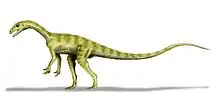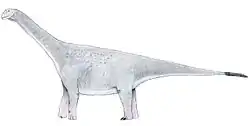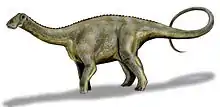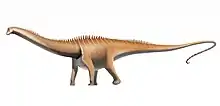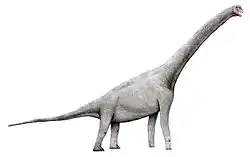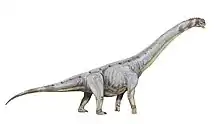Eucamerotus
Eucamerotus (meaning "well-chambered", in reference to the hollows of the vertebrae) was a genus of sauropod dinosaur from the Barremian-age Lower Cretaceous Wessex Formation (Wealden) of the Isle of Wight, England.
| Eucamerotus | |
|---|---|
| Scientific classification | |
| Kingdom: | Animalia |
| Phylum: | Chordata |
| Clade: | Dinosauria |
| Clade: | Saurischia |
| Suborder: | †Sauropodomorpha |
| Clade: | †Sauropoda |
| Clade: | †Eusauropoda |
| Clade: | †Neosauropoda |
| Clade: | †Macronaria |
| Clade: | †Titanosauriformes |
| Genus: | †Eucamerotus Hulke, 1872 |
| Species: | †E. foxi |
| Binomial name | |
| †Eucamerotus foxi Blows, 1995 | |
History and taxonomy
John Hulke erected the genus in 1872 for "NHMUK R.2522", a neural arch found by William D. Fox near Brighstone Bay, but provided no species name. He considered the Ornithopsis hulkei lectotype referable to the genus.[1][2] He later referred NMHUK R.2522 to Ornithopsis, synonymizing Eucamerotus with Seeley's name based on the discovery of additional vertebrae from the Isle of Wight.[3] Later authors treated Eucamerotus as a synonym of Pelorosaurus.[4][5][6]
William T. Blows resurrected the genus in 1995 as a valid brachiosaurid, added the specific name and added the species epithet foxi, designating the various vertebrae that Hulke (1879, 1880) had referred to Ornithopsis as paratypes, while referring additional vertebrae and partial skeleton MIWG-BP001 to it.[7] This last point has not been generally accepted;[2][8] unfortunately, this skeleton has never been officially described.
Naish and Martill (2001) suggested Eucamerotus was a dubious brachiosaurid, and did not find Blows' characters convincing.[2] Upchurch et al. (2004) considered it to be a dubious sauropod.[8] However, a more recent review of Wealden sauropods from England places Eucamerotus as a valid genus of Titanosauriformes incertae sedis.[9]
Paleobiology
The vertebrae are around twenty centimetres long. If a brachiosaurid, Eucamerotus may have been around 15 m (49.2 ft) long,[2] small for a sauropod. As any kind of sauropod, it would have been a quadrupedal herbivore.[8]
References
- Hulke, J. W. (1872). "Appendix to a "Note on a new and undescribed Wealden Vertebra," read 9th February 1870, and published in the Quarterly Journal for August in the same year". Quarterly Journal of the Geological Society. 28 (1–2): 36–38. doi:10.1144/GSL.JGS.1872.028.01-02.15.
- Naish, D., and Martill, D.M. (2001). Saurischian dinosaurs 1: Sauropods. In: Martill, D.M., and Naish, D. (eds.). Dinosaurs of the Isle of Wight. The Palaeontological Association:London 185-241. ISBN 0-901702-72-2
- Hulke, J. W. (1879). "Note (3rd) on (Eucamerotus, Hulke) Ornithopsis, H. G. Seeley, = Bothriospondylus magnus, Owen, = Chondrosteosaurus magnus, Owen". Quarterly Journal of the Geological Society. 35 (1–4): 752–762. doi:10.1144/GSL.JGS.1879.035.01-04.55.
- von Huene, F. (1909). Skizze zu einer Systematik und Stammesgeschichte der Dinosaurier. Centralblatt für Mineralogie, Geologie und Paläontologie 1909:12-22. [German]
- Romer, A.S. (1956). Osteology of the Reptiles. University of Chicago Press:Chicago 1-772. ISBN 0-89464-985-X
- Steel, R. (1970). Part 14. Saurischia. Handbuch der Paläoherpetologie/Encyclopedia of Paleoherpetology. Part 14. Gustav Fischer Verlag:Stuttgart p. 1-87.
- Blows, W.T. (1995). "The Early Cretaceous brachiosaurid dinosaurs Ornithopsis and Eucamerotus from the Isle of Wight, England" (PDF). Palaeontology. 38 (1): 187–197.
- Upchurch, P.M., Barrett, P.M., and Dodson, P. (2004). Sauropoda. In: Weishampel, D.B., Dodson, P., and Osmólska, H. (eds.). The Dinosauria (2nd edition). University of California Press:Berkeley 259-322. ISBN 0-520-24209-2
- Upchurch, P., Mannion, P. D. & Barrett, P. M. 2011. Sauropod dinosaurs. In Batten, D. J. (ed.) English Wealden Fossils. The Palaeontological Association (London), pp. 476-525.
